11.07.2019
China's Chang'e-4 probe switches to dormant mode
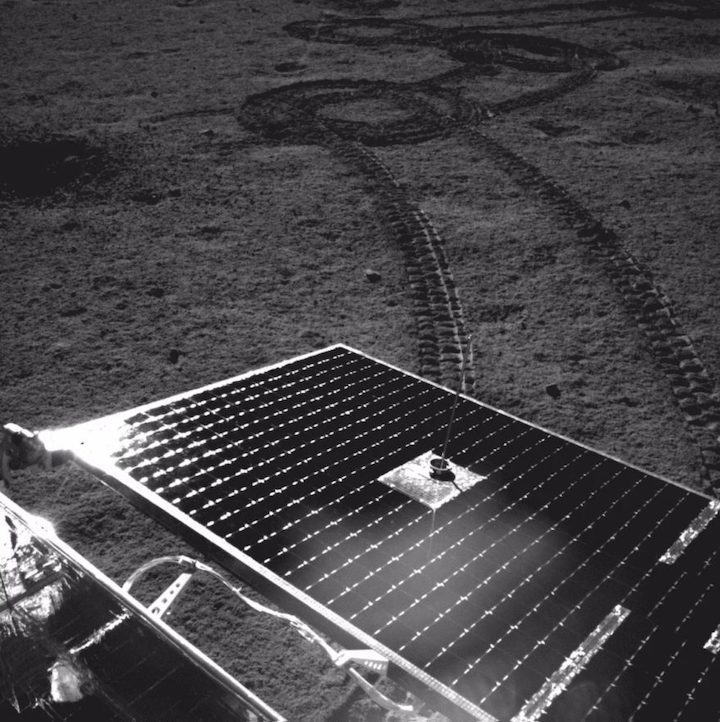
Both the lander and the rover of the Chang'e-4 probe switched to dormant mode for the lunar night on the far side of the moon on Tuesday morning (Beijing Time).
The scientific instruments on the Chang'e-4 probe worked well during the seventh lunar day after the probe made the first-ever soft-landing on the Von Karman Crater in the South Pole-Aitken Basin on the far side of the moon on Jan. 3, according to the Lunar Exploration and Space Program Center of the China National Space Administration.
A new batch of 1.2 G scientific detection data obtained by the probe was sent to the core research team for analysis in early July.
A lunar day equals 14 days on Earth, and a lunar night is the same length. The Chang'e-4 probe switched to a dormant mode during the lunar night due to the lack of solar power.
As a result of the tidal locking effect, the moon's revolution cycle is the same as its rotation cycle, and the same side always faces Earth.
The scientific tasks of the Chang'e-4 mission include low-frequency radio astronomical observation, surveying the terrain and landforms, detecting the mineral composition and shallow lunar surface structure and measuring neutron radiation and neutral atoms.
The Chang'e-4 mission embodies China's hope to combine human wisdom in space exploration with four payloads developed by the Netherlands, Germany, Sweden and Saudi Arabia.
Quelle: Xinhua
----
Update: 8.08.2019
.
New Images from China’s Chang’e 4 as Eighth Lunar Day Ends
China’s Chang’e 4 mission is continuing its science and exploration work on the farside of the Moon, having completed its eighth lunar day of activities on Wednesday.

This composite image showing the shadow of the Yutu-2 rover, roving tracks, and the distant Chang’e 4 lander was taken during lunar day 7.
CNSA / CLEP
China's Chang’e 4 lunar lander and Yutu 2 (Jade Rabbit 2) rover powered down at 9:00 and 9:50 Universal Time (UT), respectively, on August 7th, just under 24 hours ahead of local sunset, according to an update (Chinese) from the China Lunar Exploration Program (CLEP).
The Yutu 2 rover has now covered a total of 271 meters (890 feet) since its deployment and continues to make its way west of the landing site in Von Kármán Crater. Chang'e 4 landedin the 180-km-diameter (112-mile) crater, which lies within the immense South Pole-Aitken impact basin, following local lunar sunrise on January 3rd. NASA’s Lunar Reconnaissance Orbiter has been tracking Chang'e 4's progress as it passes overhead.
Despite passing its design lifetime of three lunar days, or three Earth months, Yutu 2 is apparently continuing to drive well. The rover has even increased its drive distance in recent lunar days, driving 33.13 meters during lunar day 8, the farthest since the 43 meters it covered in lunar day 3. The rover has adapted to and overcome earlier issues that arose when reflections from the craft triggered obstacle alerts.
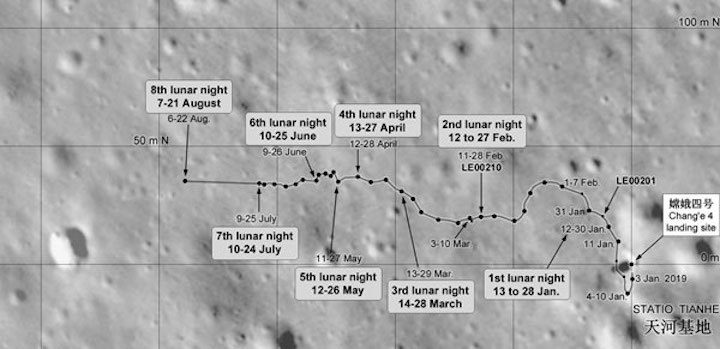
This map of Yutu 2's drive was produced by space exploration historian and cartographer Phil Stooke. The route for lunar days 6, 7 and 8 are early estimates.
Phil Stooke
Science Returns
While traversing the complex lunar terrain, Yutu 2 is also carrying out several science objectives. Progress is slow because, while the rover is solar powered, it actually shuts down for six days in the middle of the 14-day period of sunshine, a precaution against the high, direct solar radiation over the landing site. That leaves just over three days on each side of these "naps" for roving and measurements.
Nevertheless, the rover is returning intriguing results. A mission source told this reporter that the Lunar Penetrating Radar (LPR) experiment aboard the rover has returned "very interesting radar data for lunar subsurface analysis" along the roving route. A paper on the data has been submitted and is awaiting acceptance and publication.
That paper will follow first science results published inMay in the journal Nature, which were based on in situ observations made by the Visible and Near Infrared Spectrometer, another payload aboard Yutu 2. The data indicate the presence of materials that might have originated from below the Moon’s crust. The find is in line with the idea that the impact that created the South Pole-Aitken Basin may have excavated material from the lunar mantle.
Science will also soon be coming from the Queqiao relay satellite, which facilitates communications between Chang'e 4 and Earth from its halo orbit around the Earth-Moon L2 Lagrangian point. The satellite also carries the Netherlands-China Low-Frequency Explorer (NCLE), a pathfinder experiment for low-frequency radio astronomy. The instrument's five 3-meter-long antennae are slowly being deployed in intervals to allow testing and calibration. In the coming months, NCLE will begin observations across a frequency range between 1 and 80 MHz; observations below 30 MHz are only possible in space.
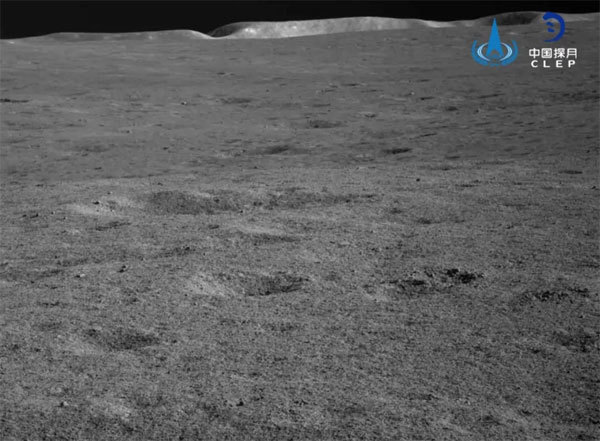
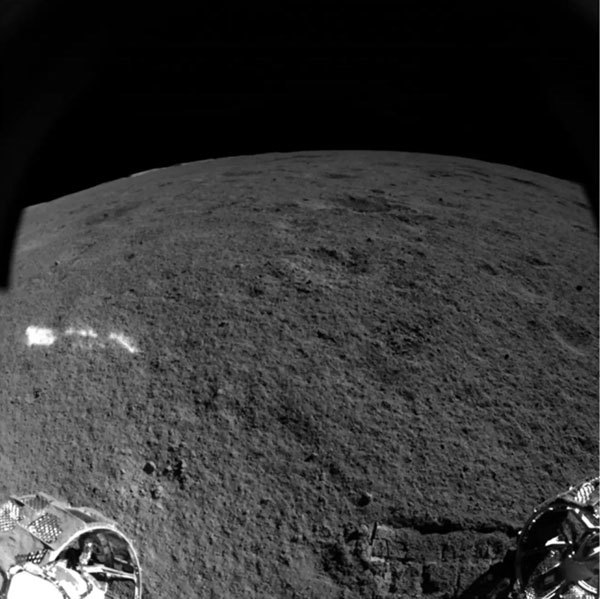
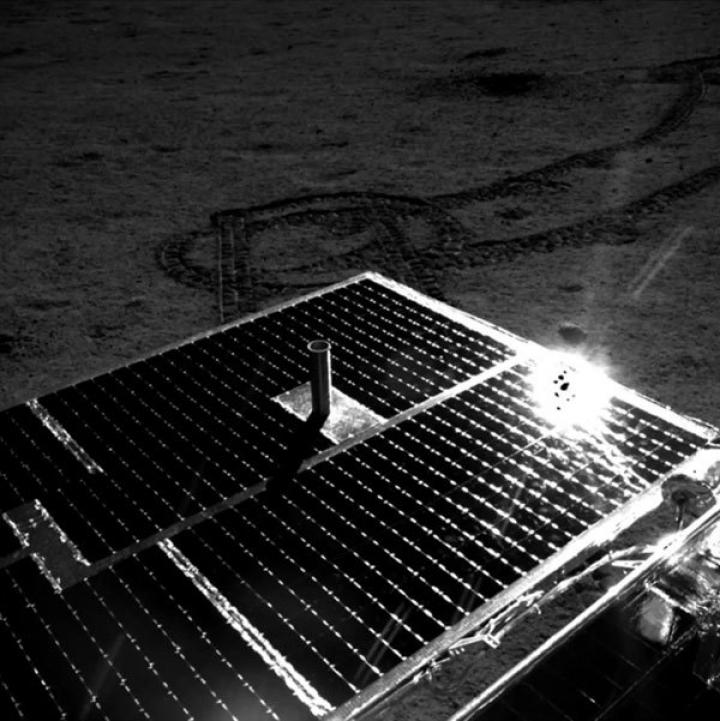
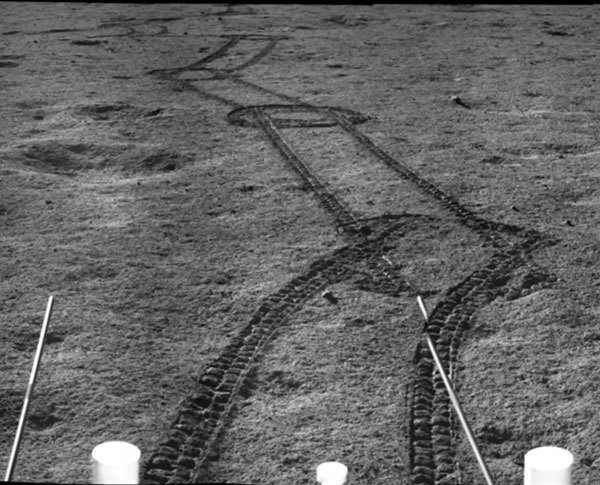
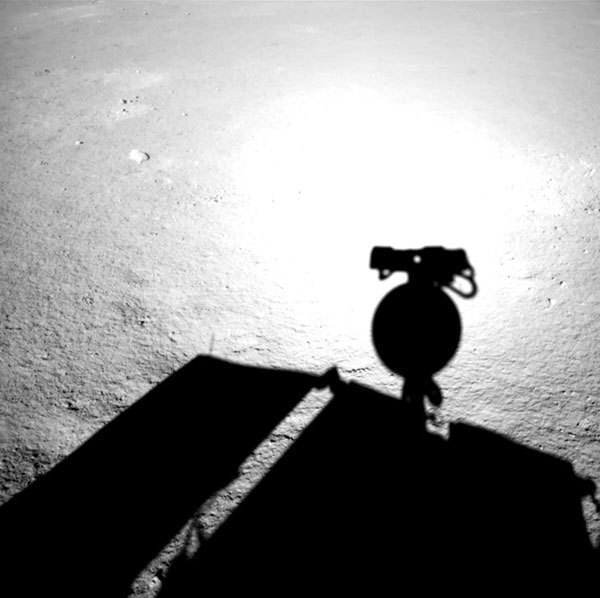

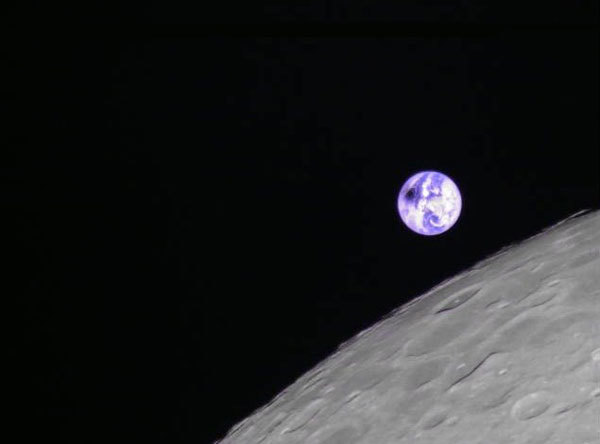
Longjiang 2 was orbiting the Moon when it captured the July 2nd total solar eclipse over the Pacific Ocean. Harbin Institute of Technology
Second Farside "Landing"
China’s second visit to the farside of the Moon came on July 31st, but it wasn't a soft landing. A tiny, 47-kilogram satellite that launched with Queqiao, Longjiang-2/DSLWP-B, collided at high speed with the Moon. The mission, which lasted over a year, was part technology verification and part pioneering amateur radio and imaging satellite.
Based on earlier mission behavior, Yutu 2 will likely begin lunar day 9 activities on August 24th, around 24 hours after local sunrise. The Chang’e 4 lander will then wake up another 24 hours later.
Quelle: Sky&Telescope
----
Update: 9.08.2019
.
China's lunar rover travels 271 meters on moon's far side
China's lunar rover Yutu-2 has driven 271 meters on the far side of the moon to conduct scientific exploration on the virgin territory.
Both the lander and the rover of the Chang'e-4 probe switched to its dormant mode for the lunar night on Wednesday (Beijing time), according to the Lunar Exploration and Space Program Center of the China National Space Administration.
China's Chang'e-4 probe, launched on Dec. 8, 2018, made the first-ever soft landing on the Von Karman Crater in the South Pole-Aitken Basin on the far side of the moon on Jan. 3.
A lunar day equals 14 days on Earth, a lunar night the same length. The Chang'e-4 probe switches to dormant mode during the lunar night due to lack of solar power.
During the eighth lunar day of the probe on the moon, the scientific instruments on the lander and rover worked well, and a new batch of scientific detection data were sent to the core research team for analysis.
As a result of the tidal locking effect, the moon's revolution cycle is the same as its rotation cycle, and the same side always faces Earth.
The far side of the moon has unique features, and scientists expect Chang'e-4 could bring breakthrough findings.
The scientific tasks of the Chang'e-4 mission include low-frequency radio astronomical observation, surveying the terrain and landforms, detecting the mineral composition and shallow lunar surface structure and measuring neutron radiation and neutral atoms.
The Chang'e-4 mission embodies China's hope to combine wisdom in space exploration with four payloads developed by the Netherlands, Germany, Sweden and Saudi Arabia.
China's Chang'e-4 Rover Keeps Snapping Stunning Photos of the Moon's Far Side
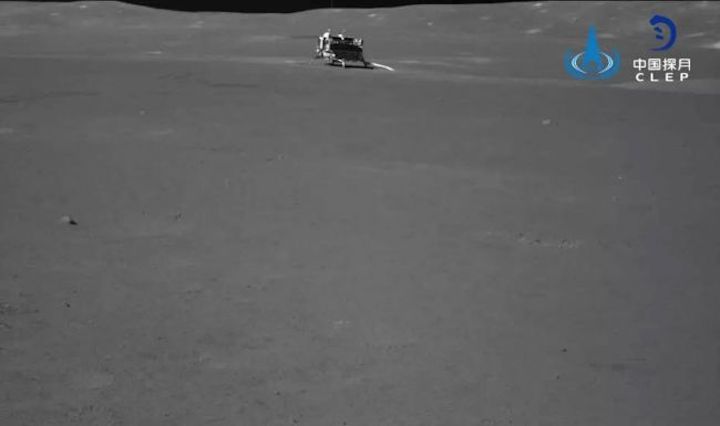
China's Chang'e-4 mission has completed eight full days of science work on the far side of the moon — and in between the experiments, the lander and rover have sent home some new photographs, too.
The mission touched down in early January, becoming the first robotic mission to land on the far side of the moon. Here, days and nights each last the equivalent of about two weeks on Earth, and the nights are brutally cold.
But for now, the mission seems to be holding up against the harsh conditions. During their seventh workday, which ended on July 9, the two robots completed a range of measurements using neutron detectors, radiation instruments, infrared spectrometers and radio devices.
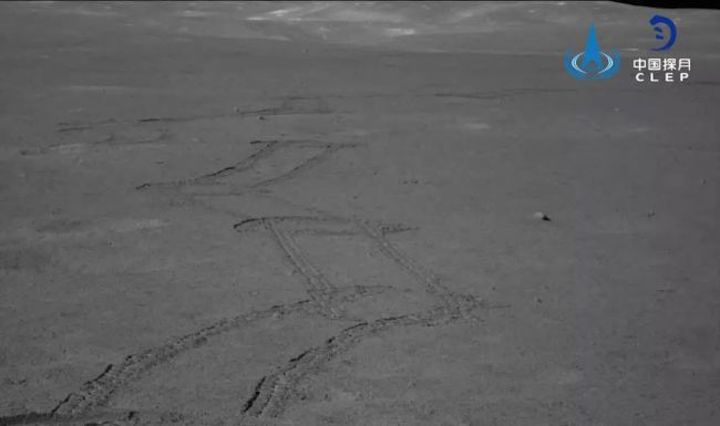
A photograph of the Yutu-2 rover's tracks on the moon.
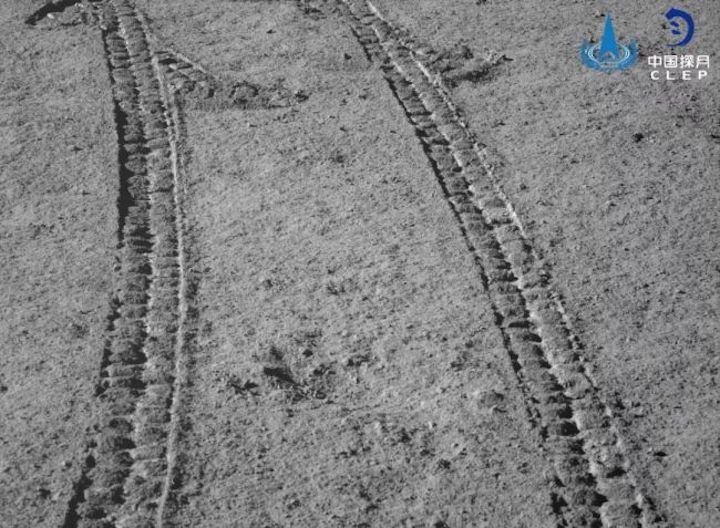
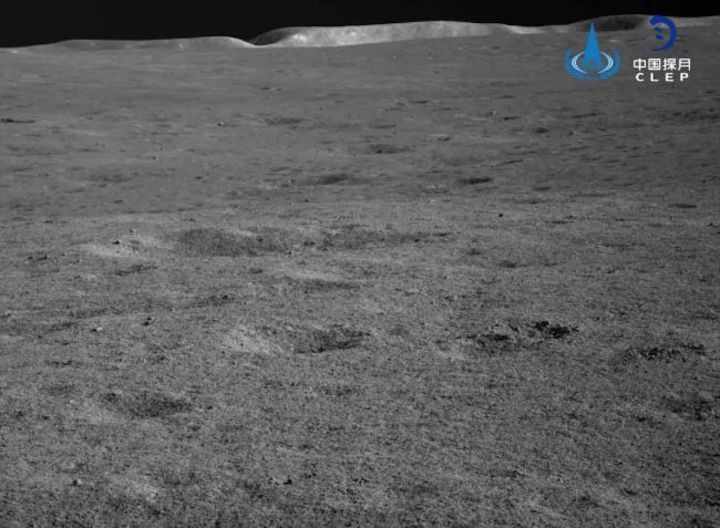
The duo then powered down for a two-week nap to wait out the frigid night before waking up again on July 26 for another workday that ended on Aug. 7. According to the China Lunar Exploration Project, by the end of that eighth workday, the rover had traveled a total of 890 feet (271 meters) across the far side of the moon.
The far side of the moon is quite different from the side we're used to seeing from Earth, and scientists don't understand how those differences arose. They hope the data gathered by the Chang'e-4 lander and Yutu-2 rover will help decipher that mystery.
Quelle: SC
----
Update: 25.08.2019
.
China's Chang'e-4 probe resumes work for ninth lunar day
The lander and rover of the Chang'e-4 probe have resumed work for the ninth lunar day on the far side of the moon after "sleeping" during the extremely cold night.
The lander woke up at 8:10 a.m. Sunday, and the rover, Yutu-2 (Jade Rabbit-2), awoke at 8:42 a.m. Saturday, according to the Lunar Exploration and Space Program Center of the China National Space Administration.
For the ninth lunar day, the lander's neutron radiation detector and low-frequency radio detector, as well as the rover's infrared imaging spectrometer and other instruments will be restarted to conduct scientific tasks including moon surface observation and composition analysis.
China's Chang'e-4 probe, launched on Dec. 8, 2018, made the first-ever soft landing on the Von Karman Crater in the South Pole-Aitken Basin on the far side of the moon on Jan. 3.
A lunar day equals 14 days on Earth, and a lunar night is the same length. The Chang'e-4 probe switches to a dormant mode during the lunar night due to the lack of solar power.
As a result of the tidal locking effect, the moon's revolution cycle is the same as its rotation cycle, and the same side always faces Earth.
The scientific tasks of the Chang'e-4 mission include low-frequency radio astronomical observation, surveying the terrain and landforms, detecting the mineral composition and shallow lunar surface structure and measuring neutron radiation and neutral atoms.
The Chang'e-4 mission embodies China's hope to combine human wisdom in space exploration with four payloads developed by the Netherlands, Germany, Sweden and Saudi Arabia.
Quelle: Xinhua
----
Update: 10.09.2019
.
China's lunar rover travels over 284 meters on moon's far side
China's lunar rover Yutu-2 has driven 284.66 meters on the far side of the moon to conduct scientific exploration on the virgin territory.
Both the lander and the rover of the Chang'e-4 probe switched to its dormant mode for the lunar night on Friday (Beijing time), according to the Lunar Exploration and Space Program Center of the China National Space Administration.
China's Chang'e-4 probe, launched on Dec. 8, 2018, made the first-ever soft landing on the Von Karman Crater in the South Pole-Aitken Basin on the far side of the moon on Jan. 3.
A lunar day equals 14 days on Earth, a lunar night the same length. The Chang'e-4 probe switches to dormant mode during the lunar night due to lack of solar power.
During the ninth lunar day of the probe on the moon, the scientific instruments on the lander and rover worked well, and a new batch of 2.9 GB scientific detection data was sent to the core research team for analysis.
As a result of the tidal locking effect, the moon's revolution cycle is the same as its rotation cycle, and the same side always faces Earth.
The far side of the moon has unique features, and scientists expect Chang'e-4 could bring breakthrough findings.
The scientific tasks of the Chang'e-4 mission include low-frequency radio astronomical observation, surveying the terrain and landforms, detecting the mineral composition and shallow lunar surface structure and measuring neutron radiation and neutral atoms.
The Chang'e-4 mission embodies China's hope to combine wisdom in space exploration with four payloads developed by the Netherlands, Germany, Sweden and Saudi Arabia.
Quelle: Xinhua
----
Update: 20.09.2019
.
China's Lunar Rover Scopes Out Weird Substance on Far Side of the Moon (Photos)
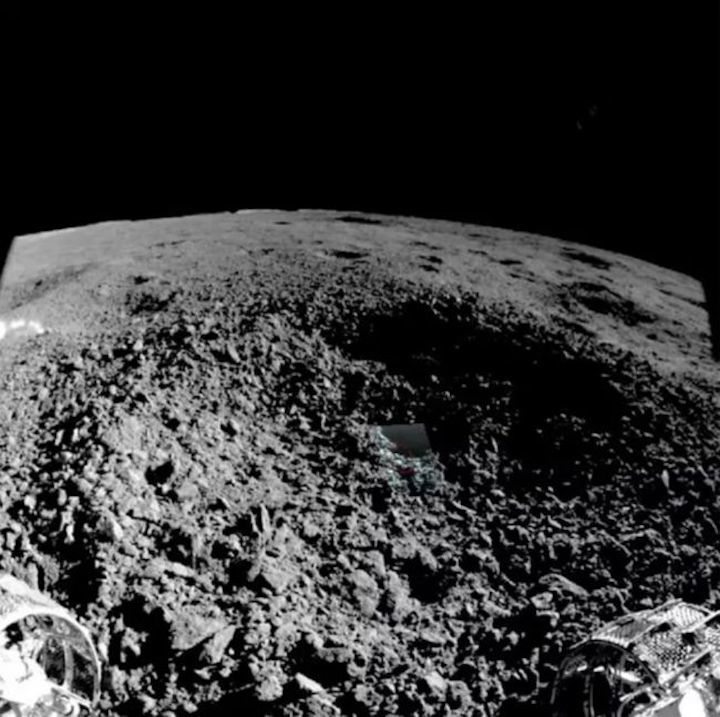
China's Yutu-2 moon rover captured this image from the edge of the small crater where it found a mysterious, gel-like material.
China's lunar exploration program has released images that give us a glimpse of the mysterious material discovered on the far side of the moon.
Yutu-2, the lunar rover for China's Chang'e-4 mission, grabbed attention last month after its drive team spotted something unusual while roving close to a small crater. The Chinese-language science outreach publication Our Space, which announced the findings on Aug. 17, used the term "胶状物" (jiao zhuang wu), which can be translated as "gel-like." This notion sparked wide interest and speculation among lunar scientists.
Scientists have now gotten a look at that curious material, thanks to a post (Chinese) released over the weekend by Our Space via its WeChat social media account. Along with new images of the stuff on the moon, the post details how the Yutu-2 team carefully approached the crater in order to analyze the specimen, despite risks.
The clearest image shows two of the rover's six wheels and the contents of an approximately 7-foot-wide (2 meters) crater.
The compressed, black-and-white shot comes from an obstacle-avoidance camera on the rover. The green, rectangular area and red circle within are suspected to be related to the field of view of the Visible and Near-Infrared Spectrometer (VNIS) instrument, rather than the subject matter itself, according to some lunar scientists.
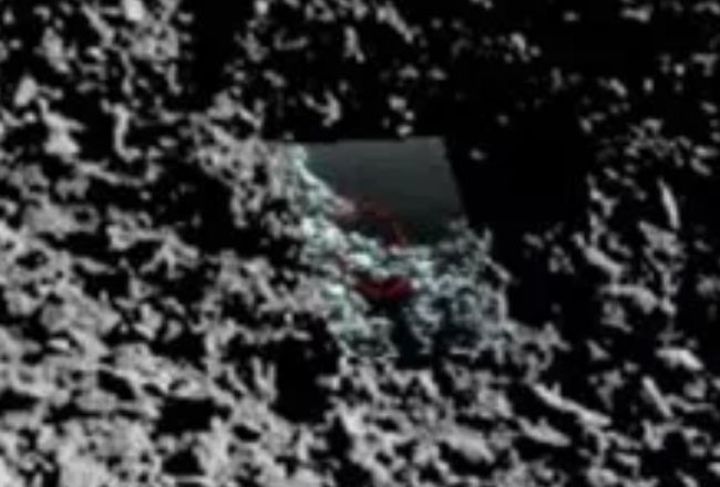
A cropped image showing the highlighted area with the crater.
VNIS is one of Yutu-2's four science payloads. It detects light that is scattered or reflected off materials to reveal their chemical makeup. As VNIS has a small field of view, the drive team needed to carefully navigate Yutu-2 to make a detection without falling into the crater.
After obtaining the first set of data that VIRS collected at the crater in July, the Yutu-2 team deemed it to be unsatisfactory due to shadows, so the team members attempted a second approach and measurement during the following lunar day in August. According to Our Space, a satisfactory detection was made — but the results were not released.

An image showing Yutu-2's shadow and tracks from when it approached the crater.
Clive Neal, a lunar scientist at the University of Notre Dame, told Space.com that while the image is not great, it may still give clues to the nature of the material.
Neal said that the material highlighted in the center of the crater resembles a sample of impact glass found during the Apollo 17 mission in 1972. Sample 70019 was collected by astronaut Harrison Schmitt, a trained geologist, from a fresh crater 10 feet (3 meters) in diameter, similar to that approached by Yutu-2.
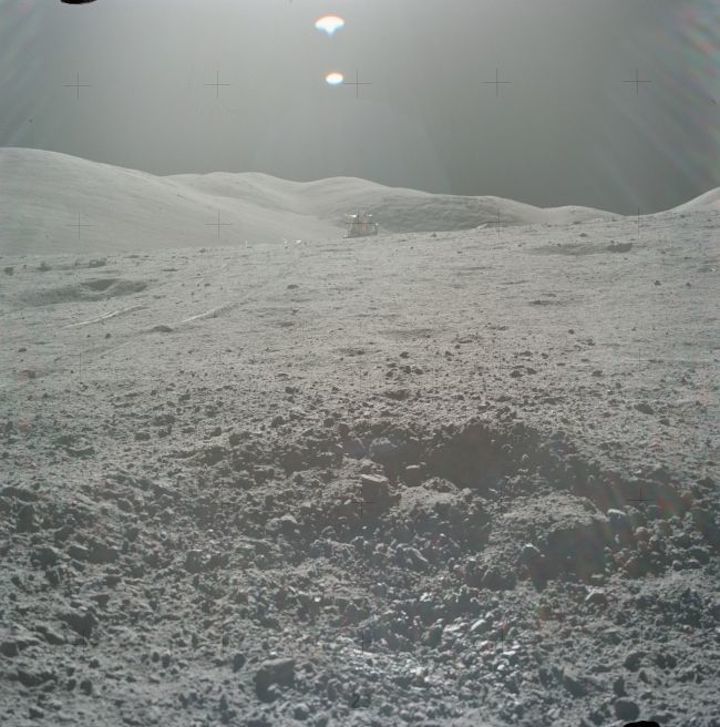
The crater containing sample 70019, with the Apollo 17 lunar module in the background.
Neal describes 70019 as being made of dark, coherent microbreccia — broken fragments of minerals cemented together — and black, shiny glass. "I think we have an example here of what Yutu-2 saw," Neal said.
High-speed impacts on the lunar surface melt and redistribute rock across the craters they make and can create glassy, igneous rocks and crystalline structures.
As for being unusual and "mysterious," as described by the initial Chinese account, "having craters looking like those from Yutu-2 and where 70019 was collected is to be expected," Neal said.
The initial observation that commanded the attention of the drive team was made from an image from Yutu-2's Panoramic Camera (PCAM). The Chang'e-3 mission's Yutu rover, which landed on the near side in 2013, returned impressive, high-resolution color images of the lunar landscape using its PCAM
The Yutu-2 team will have great images to work with, and these may suggest something different. However, images from the Chang'e-4 mission might be released publicly as long as one year after they have been taken.
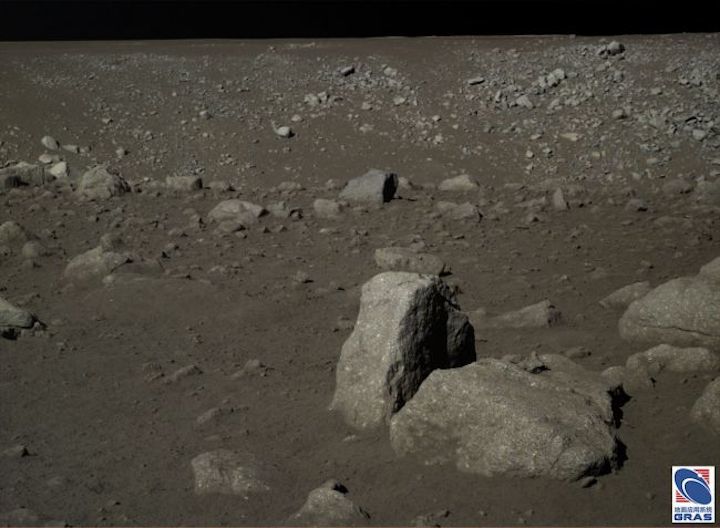
An image from Mare Imbrium taken by the PCAM on Yutu-1.
Dan Moriarty, NASA Postdoctoral Program Fellow at the Goddard Space Flight Center in Greenbelt, Maryland, agrees that it is hard to make a definitive assessment of the substance's chemical composition, given the poor image quality and overlying colored section in the Yutu-2 image.
Moriarty told Space.com that the outlined material appears somewhat brighter than surrounding materials, though the actual brightness is hard to confirm from the photographs. If so, the contrast could be due to the differing origins of the respective materials.
"Chang'e-4 landed in a mare basalt-filled crater, which is typically dark," Moriarty said. "Highlands crustal materials are typically brighter, so that would be a potential candidate."
"It will be very interesting to see what the spectrometer sees, and if any higher-resolution images become available," Moriarty notes.
Chang'e-3's Yutu rover carried an alpha particle X-ray spectrometer for analyzing chemical composition, mounted on a robotic arm, which would be very useful for identifying such specimens. Yutu-2 instead carries the new Advanced Small Analyzer for Neutrals (ASAN), a payload from Sweden for studying how solar winds interact with the lunar surface.
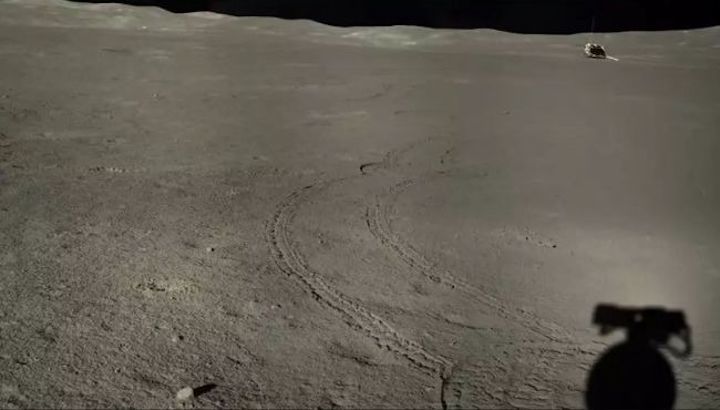
A stitched image from Yutu-2 looking back toward the Chang'e-4 lander during lunar day 7, in late June and early July 2019.
The Chang'e-4 lander and Yutu-2 completed the ninth lunar day of their mission on Sept. 5, powering down around 24 hours ahead of local sunset. Lunar day 10 will begin around Sept. 22 for Yutu-2 and Sept. 23 for the lander. (On the moon, a day lasts about two weeks.)
Yutu-2 has been heading west of the Chang'e-4 landing site in the Von Kármán crater since the historic Jan. 2 lunar far side landing, covering 934 feet (285 meters) so far.
Quelle: SC
----
Update: 25.09.2019
.
Chinese scientists reconstruct Chang'e-4 probe's landing on moon's far side
Chinese scientists have reconstructed the descent trajectory of the Chang'e-4 lunar probe and determined its precise landing site on the far side of the moon in a move that could bolster further deep space exploration.
China's Chang'e-4, launched on Dec. 8, 2018, made the first-ever soft landing on the moon's far side in the Von Karman Crater in the South Pole-Aitken on Jan. 3.
Using high-resolution topographic data obtained by the Chang'e-2 lunar probe and images taken by Chang'e-4 during its descent and exploration, researchers reconstructed the landing process including how it avoided obstacles autonomously.
"Chang'e-4 landed on a gentle slope of a degraded impact crater, and is surrounded by five impact craters. It's only 8.35 meters from the rim of a crater with a diameter of 25 meters to the north," said Li Chunlai, vice director of the National Astronomical Observatories of the Chinese Academy of Sciences (NAOC) and research leader.
Scientists calculated the precise location of the landing site at 177.5991 degrees east longitude and 45.4446 degrees south latitude with an elevation of -5,935 meters.
An article reproducing the entire successful landing process, written by the research team, was published in the latest issue of the academic journal Nature Communications.
Soft-landing on the lunar surface is a short and fast-moving process, and it is hard to control in real time from the earth. The lunar lander has to land autonomously using on-board sensors.
As a result of the tidal locking effect, the moon's revolution cycle is the same as its rotation cycle, and the same side always faces the earth.
Before the Chang'e-4 mission, there were 20 successful soft landings on the moon over the past six decades, but all of them were on the near side and the descent trajectories and landing positions of the spacecraft could be measured from the earth.
However, the landing process of Chang'e-4 on the far side of the moon could not be tracked and measured by ground facilities.
The new study not only provides background information and position benchmarks for the scientific exploration of the lander and rover of the Chang'e-4 probe, and the basis of high-precision lunar surveying and mapping, but also technological support for China's future deep space exploration, such as landing on asteroids or Mars, said Liu Jianjun, a researcher at NAOC.
The far side of the moon has unique features, and scientists expect Chang'e-4 could make pioneering discoveries.
The scientific tasks of the Chang'e-4 mission include low-frequency radio astronomical observation, surveying the terrain and landforms, detecting the mineral composition and shallow lunar surface structure, and measuring neutron radiation and neutral atoms.
The mission embodies China's hope to combine wisdom in space exploration with four payloads developed by the Netherlands, Germany, Sweden and Saudi Arabia.
Quelle:Xinhua
+++
China's lunar rover discovers mysterious substance on moon's far side
China's lunar rover Yutu-2, or Jade Rabbit-2, discovered an unidentified substance in an impact crater on the far side of the moon.
The discovery was made during Yutu-2's ninth lunar day of exploration on the moon, according to the Lunar Exploration and Space Program Center of the China National Space Administration.
The ground controllers designed a driving route for the rover to allow it to conduct scientific detection to the depth of the impact crater and the distribution of the ejecta, said the center.
"The Yutu-2 rover is expected to bring us more surprises and scientific discoveries," said the center.
The lander of the Chang'e-4 probe and the Yutu-2 rover have resumed work for the 10th lunar day on the far side of the moon after "sleeping" during the extremely cold lunar night.
The lander woke up at 8:26 p.m. Monday, and the rover awoke at 8:30 p.m. Sunday (Beijing Time). Both are in normal working condition, according to the center.
The rover has traveled about 285 meters on the moon to conduct scientific exploration on the virgin territory.
China's Chang'e-4 probe, launched on Dec. 8, 2018, made the first-ever soft landing on the Von Karman Crater in the South Pole-Aitken Basin on the far side of the moon on Jan. 3.
A lunar day equals 14 days on Earth, and a lunar night is the same length. The Chang'e-4 probe switched to a dormant mode during the lunar night due to the lack of solar power.
As a result of the tidal locking effect, the moon's revolution cycle is the same as its rotation cycle, and the same side always faces Earth.
The scientific tasks of the Chang'e-4 mission include low-frequency radio astronomical observation, surveying the terrain and landforms, detecting the mineral composition and shallow lunar surface structure and measuring neutron radiation and neutral atoms.
The Chang'e-4 mission embodies China's hope to combine human wisdom in space exploration with four payloads developed by the Netherlands, Germany, Sweden and Saudi Arabia.
Quelle:Xinhua
+++
Spacecraft’s descent on the dark side of the moon is revealed
Chinese scientists have ingeniously worked out where Chang’e-4 landed. Richard A Lovett reports.
Earlier this year, on 3 January, China’s Chang’e-4 (CE-4) spacecraft made an historic first by touching down safely on the far side of the Moon.
All prior landings, manned or robotic, had been on the nearside, including China’s own Chang’e-3, which safely arrived in 2013. Landing on the farside is more difficult because, with the bulk of the Moon lying in the way, mission controllers on Earth have no direct way to communicate with the lander.
To solve this, the Chinese space agency began by launching a communication satellite called Queqiao into a stationary orbit about a million kilometers above the Moon. That allowed it to relay signals between Earth and Chang’e.
Using that, the Chinese team has been able to conduct investigations on the Moon, including piloting and collecting data from Chang’e-4’s rover, Yutu-2, which so far has trundled across 285 meters of the Lunar surface and, among other things, discovered rocks that appear to have been ejected from the Moon’s mantle by an ancient, deep impact.
But one thing has been elusive: Change’e-4 remains out of sight from Earth, and nobody was really sure exactly where it was. Sure, they knew it had come down in Von Kármán crater, a 180-kilometer depression in the Moon’s southern hemisphere, almost directly opposite the Earth. But with no Earth-based radio tracking or telemetry, the exact location wasn’t precisely known.
To find it, Jianjun Liu of the Chinese Academy of Sciences, Beijing, and colleagues used images from the spacecraft’s landing camera, transmitted back to Earth via the Quequiao satelite after the landing, to reconstruct the spacecraft’s track during its descent. They also used photos of Chang’e’s landing site sent back by the Yutu-2 rover as it began its explorations.
Based on these, and maps of the Lunar farside provided by NASA’s Lunar Reconnaissance Orbiter, the Chinese scientists were able not only to pinpoint the spacecraft’s landing site within a couple of meters, but to deduce its descent trajectory, as the autopilot sought out a safe landing site.
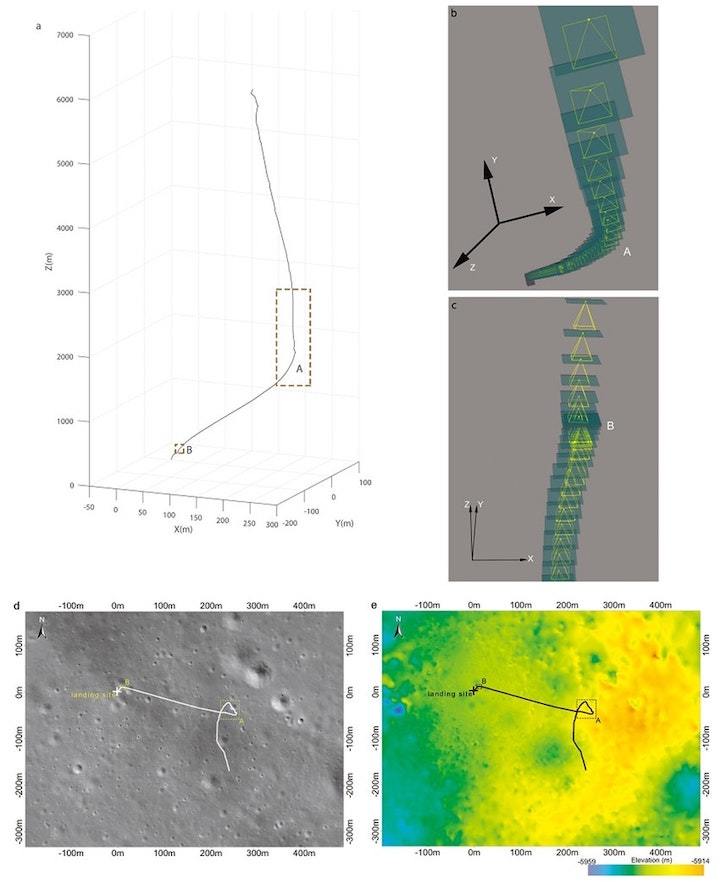
The CE-4 powered descent trajectory.
Drawing on 180 images snapped by the landing camera during the final three minutes of descent, Liu’s team reports, “we reconstructed the descent trajectory, showing even barely perceivable maneuvers of the spacecraft during the landing approach.”
The result, says one non-Chinese scientist, who asked not to be identified in order to commment as an “interested observer” rather than an expert on Moon landings, appears to be mostly an engineering study of “how they did the landing and how the lander figured out the terrain to stay close to target and not land on a big boulder.”
The scientist adds: “I can imagine engineers at NASA will find this quite interesting as they plan the next landing mission, somewhere.”
Liu’s team says the finding is also important for ground-truthing orbital maps of the Moon. “As a permanent artificial landmark on the lunar farside, the location of the CE-4 lander...can serve as a potential control point,” they write. “The result will provide a worthy geodetic data point for ... subsequent lunar exploration.”
Quelle: COSMOS
